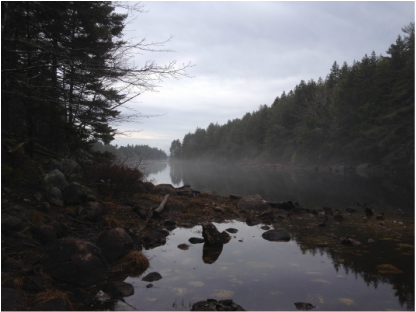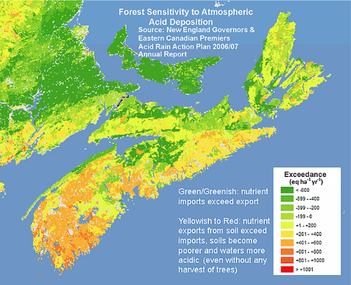|
(published in the The Halifax Herald 03/04/2017)
NOVA SCOTIA FORESTRY: Don’t listen to industry reassurances Public losing confidence in government role in forestry by MIKE PARKER I conceive that the land belongs to a vast family of which many are dead, few are living and countless numbers are still unborn. — Anonymous Whenever we, the public, question questionable forestry practices, government and industry invariably respond with talking points straight from The Clear-Cutters’ and Whole Tree Harvesters’ Biomass Thesaurus of Alternative-Facts. Think of the times you have been told professionals are "applying best practices and science to forest management." Or that professionals "harvest our forests and they grow back, healthier and more productive and more sustainable than they were before." And who can forget this top contender for quote of the year? "The forest is more than a resource to us. It’s a legacy for Nova Scotians and we are the proud stewards." Really? If this doesn’t work, then pulpit theatrics are ramped up: "Pessimists in Nova Scotia are still in abundance, standing in front of every industry they perceive as not fitting their narrow vision for our resources, preaching the "No" in Nova Scotia." Should that fail, spin doctors play the Trump card: "In the press there appears to be a persistent anti-forestry-resource-management bias." Not being a professional forester, I have been sloughed off in the past by the self-appointed stewards- of-the-woods as being critical, rhetorical, holier-than-thou and, the deepest cut of all, a "retiree", which I can only guess means I am old and as such my opinions are based in senility and not fact. With what fading faculties remain, I searched out a respected voice who can speak to forestry issues in Nova Scotia. I found it in the person of Dr. Jack Ward Thomas (1934-2016), a renowned American ecologist, Boone and Crockett Professor of Wildlife Conservation in the School of Forestry at the University of Montana, and thirteenth chief of the U.S. Forest Service. In 2001, Dr. Thomas presented a paper at the University of Alberta entitled Are There Lessons for Canadian Foresters Lurking South of the Border? It was based upon the successful campaign American environmentalists had recently waged against the "resource extraction community" in stopping overcutting in the national forests, aka public lands, or as we know them here, Crown lands. "Foresters were too certain of their positions of prestige and authority and, evidently, felt themselves above the messy realities of functioning over the long term in a democracy," Dr. Thomas wrote. "In the end, there are professional prerogatives that will not exist unless sanctioned by the people at large." He argued that foresters began "to do things that we had not done before (at least not at large scale) — including things that foresters themselves had, in an earlier period, coached the public to consider the personification of careless greed." "Foremost among these was the increasing practice of even-aged forest management embodying clear-cutting," he observed. And "a view from the sky revealed an ever-increasing network of roads connecting a patchwork of clear cuts." Dr. Thomas also argued that clear-cutting was "coupled with the decision, driven by considerations of economic efficiency . . . to convert ‘decadent, stagnate, biological deserts’ of late-successional (‘old-growth’) forests to young, vigorous, fast-growing, forests — often of selected single species." "These stands — or at least many of them — were, then, to be managed in a semi-agricultural fashion to maximize growth on selected trees to yield maximal economic benefits . . ." "So far as wildlife and fish were concerned," he wrote, "the forester’s mantra was, far too often, that ‘good forestry is good wildlife management.’ . . . Foresters clung tenaciously to that adage long after the emerging science clearly showed otherwise . . . Retention of biodiversity became a concern and foresters were forced to modify their objectives, and management, to deal with threatened or endangered species." Any of this sound familiar? There’s more. Dr. Thomas spoke of lessons that emerge: "Once the citizens of a democracy realize that they — in the final analysis — are the owners of the public lands, they will seek an increasing role in the management of those lands. Further, if the concerns of these citizens are ‘blown off ’ by professional land managers and politicians, they will respond by organizing to magnify their political impact . . ." Indeed, he warned that "foresters’ reputations have declined as a result of hanging on too long to models of management predicated on the application of ‘industrial strength forestry’ on both public and private lands. The myth of the omniscient forester as the complete natural resource manager is obsolete." "Forcing the application of economics based models to the exclusion of interests in biodiversity preservation, aesthetics, fish and wildlife, etc., will produce a backlash from the public." Here are other lessons Dr. Thomas’s paper offers us: • "Close relationships, if perceived of as too close, between industry and government related to exploitation of public lands can engender resentment and backlash." • "Perceived subsidies of industry’s extraction of wood from public lands will be increasingly questioned by an increasingly sensitive public." • "There is a rising ‘green movement’ in all western democracies that is likely to grow as we come more and more to face with a finite land base." • Foresters can "try to ignore the (public) or at least, marginalize their impact through political machination or accept the legitimacy of their concerns and their rights to be concerned and politically active. In the first course of action lies an increasingly contentious battle with significant defeat, with related loss of prestige and authority, a distinct possibility — even a probability. In the second course of action lies some opportunity to heed the age-old admonition, ‘Come, let us reason together’ and come to reasoned adjustments in management practices thereby heading off intensified conflict . . . " Dr. Thomas closed his analysis with these words of caution: "Accidents . . . lie ahead on the road called forest management unless you alter course. Heads up." Are you listening Premier Stephen McNeil, Natural Resources Minister Lloyd Hines, Nova Scotia MLAs? Stand up, speak up Nova Scotia. May the forest be with you and yours. Mike Parker has been researching, writing and talking about! the history and heritage of Nova Scotia's woods and waters for 30 years. His book, Nebooktook In the Woods, addresses his concerns about forestry practices in the province. His Facebook page, Woods and Waters Nova Scotia, has more information on Dr. Jack Ward Thomas.
0 Comments

In 2014-15 Nova Scotia Power upgraded their early 20th century Indian River hydro-electric system and among many other improvements installed a $4m fish ladder on their Sandy Lake dam. Archaeologists jumped at the chance - a golden low water opportunity. There they found 6,000 year old aboriginal camp sites. Clearly, connecting the province's interior with St. Margaret's Bay and the ocean, the Indian River system has been a vital transportation corridor for millennia.
Not far from where this magical picture was taken, midst three small protected areas, is the historic Old Annapolis Trail built by Queen Victoria's own father to connect the new British garrison of Halifax with the old French capital, Port Royal near Annapolis. A couple of miles from the burgeoning Tantallon Crossroads where a half-million tourists pass annually on their way to Peggy's Cove, in the middle of a vibrant recreational node for hikers, kayakers, four-wheelers, hunters, fishers, nature lovers of all stripes, the lower Indian River with its mystical lakes and old forests - a magnet for the people of St. Margaret's Bay for generations and now for the thousands of newer residents in the growing communities along the Hammonds Plains Road. Here is where the Nova Scotia Department of Natural Resources in their wisdom, thumbing their noses at public opinion, have announced massive clearcuts. Clearly the Department is much better equipped to determine highest and best use than those who actually live here. Heavy logging they say, buzz 'er off, and this on the very doorsteps of those who might see a markedly different future unfold for these lands. Attached, a letter from the people of the Bay announcing their intent:
More than 90% of the Crown forest leased by the Nova Scotia government for harvest is licensed for clearcut.
That’s right, 90%. But, the province’s Natural Resources Strategy, The Path We Share, a dubious title, clearly states that the percentage of clearcutting is to be reduced to no more than 50% by 2016. That’s this year. Now. So how does this work? 90%. 50%. Don’t ask the Healthy Forest Coalition for an explanation. Ask the Minister of Natural Resources, the Honourable Lloyd Hines.

Our soils are starved.
Forest soils over 50 per cent of our landmass are losing more nutrients than are being replaced by rainfall or natural weathering of rocks. Think acid rain. Our soils are shallow; they lie on slate, granite and felsic bedrock, and have no buffering capacity against industrial acid rain. Southwest Nova Scotia is in the worst shape. Now think clear-fells. Clear-cutting worsens the effects of acid rain by increasing nutrient losses. Remove wood and bark, stems and stumps and the land is laid bare – open to erosion and further leaching. It’s a no-win situation. No climate issues, no food production concerns – whether sustainable agriculture, denuded energy resources, runaway climate change – can be fixed without addressing the issues of forest health because forest soils are the foundation for everything. And that’s the thing. Our forests have a far higher and longer-term value than the crude market price placed on them by government. Productive soils, clean air, clean water, our social and economic well-being: all derive from healthy forests and a healthy forest floor. We need vision to sustain them, not the short-term asset stripping we see everywhere. Biologist David Patriquin outlines the dismal story in this article from the Chronicle Herald. Briefly:
The price paid in the aquatic realm began upstream. Salmon, brook trout, loons, sugar maple, salamander, songbirds: the losses are too high. The points of the ecosystem triangle – complex interactions between soils, forests and the wider environment – no longer match up. Stay the course and the future is grim. Heed the science and at least we have a chance. |
Blog Archives
October 2020
Blog Index
All
|
Photo used under Creative Commons from DaveW99999











 RSS Feed
RSS Feed
